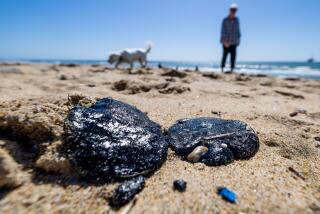New Methods Tried to Repel Spreading Slick : Oil cleanup: Workers hope an experimental pumping process will keep the crude off Saudi shores. Still, the massive spill is expected to double in size.
DHAHRAN, Saudi Arabia — Workers began an experimental pumping process Tuesday in an effort to keep a massive oil spill from Saudi Arabian shores, but scientists predicted that the slick eventually will spread, doubling in area and threatening beaches on both sides of the Persian Gulf.
U.S. military officials confirmed that the flow of crude oil at the Sea Island terminal off the Kuwaiti coast, which they and the Saudis have blamed on Iraq, has been checked completely, and the fire raging for several days at the offshore source of the spill has gone out.
But scientists said the 11-million-barrel spill, which already spans 350 square miles off the coasts of Kuwait and Saudi Arabia, is likely to grow to an estimated 700 square miles and threaten both the Saudi and Iranian coasts.
A third day of favorable winds helped hold the slick offshore, and Saudi officials employed giant shipboard water pumps to channel large quantities of seawater into the spill in an attempt to break it up and force it farther away from shore.
“They are trying it, and it might be successful,” said a spokesman for the Saudi Ministry of Petroleum and Mineral Resources. “As far as I know, it hasn’t been tried before on any other spills, but we’re hoping this will prove more successful than chemicals.”
Bert Hartly, manager of the Anchorage, Alaska, firm that oversaw cleanup of the Exxon Valdez spill, said the experimental approach of the Saudis “might do some good” in keeping crude away from particular places, like water desalination plants, but he added it did not seem a viable method for attacking the entire spill.
An international coalition of experts is scheduled to meet in Saudi Arabia today to develop a quick action plan for other measures to contain the spill before it reaches important industrial facilities on the eastern coast of Saudi Arabia.
Typically, fighting oil spills involves the deployment of boats that skim oil from the surface and pump it into holding tanks. Floating booms also can be used to contain oil or deflect its course. These techniques are most effective in calm seas; in even moderate or choppy seas, skimming and booming is difficult, and chemical dispersants are used to break up the oil when the sea is agitated.
Aramco, the giant petroleum company that manages the majority of Saudi Arabia’s oil production, established a 24-hour-a-day spill response group office at Safaniya, halfway between the Kuwaiti border and the giant petrochemical city at Jubayl.
The southernmost tip of the spill now extends to Safaniya, about 25 miles south of the Kuwaiti border, and is creeping south-southeast at the rate of seven to 12 miles a day, a Ministry of Petroleum official said.
However, winds have slowed its progress toward Jubayl, where water intakes for critical petrochemical and water desalination plants could be threatened by contact with the thick, toxic crude.
While initial estimates had said the spill would reach Jubayl by today, scientists now predict it will reach shore just north of Jubayl, but not for another six to 10 days.
Workers battling the spill hope that will give them enough time to protect the shoreline with rubber booms and take other measures to hold the oil back from sensitive coastal areas. Saudi Arabia, already equipped to handle smaller oil spills, has sent out an international appeal for additional equipment to fight a spill that has become the largest in history.
A computer model based on wind and current patterns in the gulf over the past decade predicts that a portion of the slick will move steadily down the coast of Saudi Arabia, while another section breaks off and creeps east toward Iran.
Times environmental writer Larry Stammer contributed to this report.
More to Read
Sign up for Essential California
The most important California stories and recommendations in your inbox every morning.
You may occasionally receive promotional content from the Los Angeles Times.










